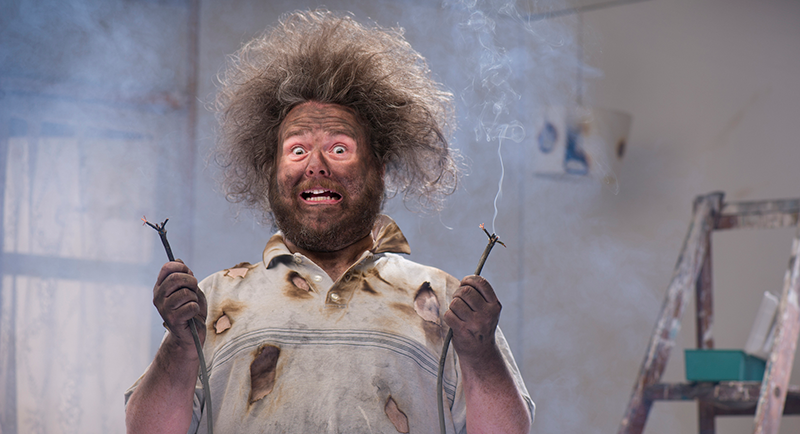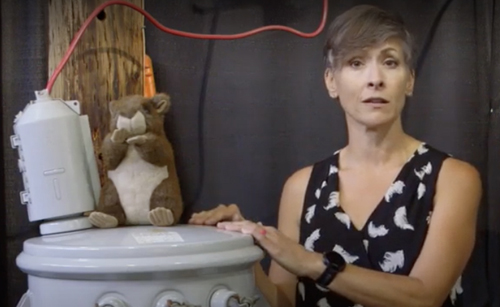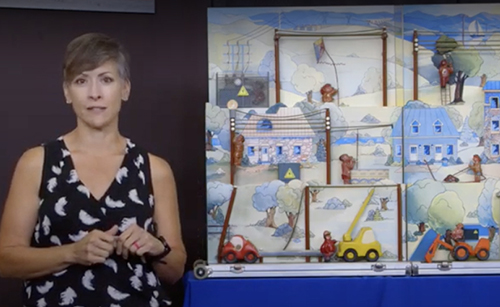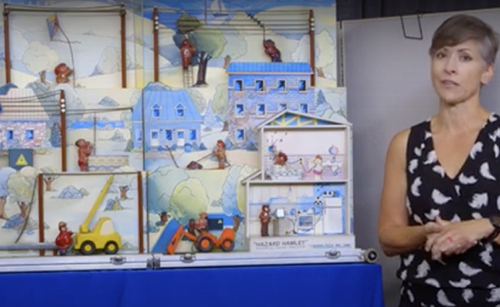Electricity is used everywhere in our world — from bedrooms and kitchens to schools and businesses, and it’s important to understand how to use it safely.
Importance of safety around electricity
Electricity travels in a path called a circuit. Electricity doesn’t want to leave the circuit, but if it can find an easier way to get to the ground, it will take it! In fact, a person can become part of the electrical circuit simply by standing on the ground (or standing on something else that touches the ground, like a ladder) and touching the circuit.
Since your body is 70% water and electricity can move through water, the body is an easy conductor of electricity. Because of this, we must be extra careful around it, especially in these situations:
Overhead electricity lines
Electric lines can be extremely dangerous. Never use ladders or poles that might touch an overhead powerline. When climbing trees, be sure to look up first and skip over any trees that might be near power lines. If an adult needs to do work near a line, they should call the electric company first.
Downed electricity lines
Sometimes storms or other events like a car accident can cause a downed line or a low-hanging electric line. You should always assume a downed line is dangerous. Don’t approach it! In the event that a downed line is discovered, an adult should call the utility company or 911 if there is a fire or someone is hurt.
Substations
Substations are areas that contain electrical equipment and high-voltage electricity. Signs and fences surround substations to warn people not to enter. Never climb the fence to enter a substation area! If something, like a ball, Frisbee or drone, has gotten lost inside the fence, ask an adult to call the electric company and someone will come get it safely.
Lightning
The odds of getting struck by lightning may be small, but that doesn’t mean safety should be ignored. Always go indoors when you hear thunder. When indoors, avoid using water, corded phones, and electronic equipment. If you can’t get indoors, find a covered shelter or vehicle. If lightning is close and you have no shelter, crouch into a ball with your hands over your ears. Avoid ridges, water, cliffs, and single trees.
How electricity can hurt you
Electricity travels at the speed of light. That’s 186,000 miles per second! If you touch a live electrical wire, there’s no way to avoid its effects, no matter how quickly you might try to let go. An electric shock is extremely painful and can be deadly.
Here’s what happens:
- When electricity enters the body, the chest muscles tighten up and make it difficult to breathe. This can make a person unconscious.
- An electric shock can also affect the heart’s rhythm so it can’t pump enough blood.
- Electricity moves so fast it creates a lot of heat. And as long as a person is in contact with electricity, it will flow in and back out and can create burns.
It’s important to know that any amount of exposure to electricity can cause an injury, and a high amount of electric current is what hurts or kills people. Current, which is measured in amps, is the rate that electrons move between two points, while voltage is the force that moves the current through a conductor or circuit. Low voltage causes the muscles to lock up, making it difficult or impossible to move away from the current. High voltage can blast a person away from the circuit, but the shock or the fall can be deadly. And remember, when a person is connected to an electrical current, they become a circuit. So if you try to help a friend being shocked, you’ll also get shocked when you touch them. Instead of trying to touch them, run and tell an adult to call 911.
Top 10 electrical safety tips to remember
- Don’t plug too many items into one outlet or extension cord. This could start a fire.
- Keep cords out of the way so pets (and small children) won’t chew on them.
- Put safety caps on electrical outlets to protect young kids.
- Unplug items by pulling from the plug (not yanking the cord!) to avoid damaging cords or outlets.
- Don’t keep plugged-in appliances close to water where they could get wet.
- Watch out for power lines when using a ladder or climbing a tree.
- Don’t fly kites or drones near power lines or substations.
- Don’t play on green transformer boxes or climb into a substation.
- Go indoors during a thunderstorm.
- In the case of a car or bus accident that involves a power line, stay in the vehicle until help arrives. The metal of the vehicle could be charged, so it’s best to wait until an adult says it’s safe to leave.

Steps to take if someone gets shocked by electricity:
- Don’t touch the person who is shocked (because you might get hurt too).
- If there are power lines on the ground, STAY AWAY.
- Call 911.
- Call Clark Public Utilities (AFTER 911) at 360-992-3000.
Mylar balloons and power lines don't mix
Traditional latex balloons have been around since the 1930s. Then in the 1970s a new balloon hit the market which was made of a thin, non-stretchable aluminized plastic film called Mylar. These balloons are now a common site at birthdays, graduations and other celebrations.
These Mylar balloons, fun though they are, have proven to be a menace to utilities and fire departments. Their aluminum coating serves as a conductor for electricity and can cause a short circuit or power surge when in contact with power lines. This can lead to power outages, melting of electrical wires, and fires, leading to possible injuries and property damage.
Unlike latex balloons, Mylar balloons that are filled with helium can stay afloat in the air for two weeks or more, posing a safety risk to our utility workers and our customers. The safety of the public and Clark Public Utilities’ workers is always a top priority. That is why we urge people to do their part in keeping our community safe.
To reduce the risk of outages and potential fires, here are some tips on how to safely and properly handle Mylar balloons:
- Never release Mylar balloons outdoors
- Use Mylar balloons indoors
- Use balloon weights or tie securely to a heavy object
- Always deflate Mylar balloons and dispose of them properly when no longer in use







